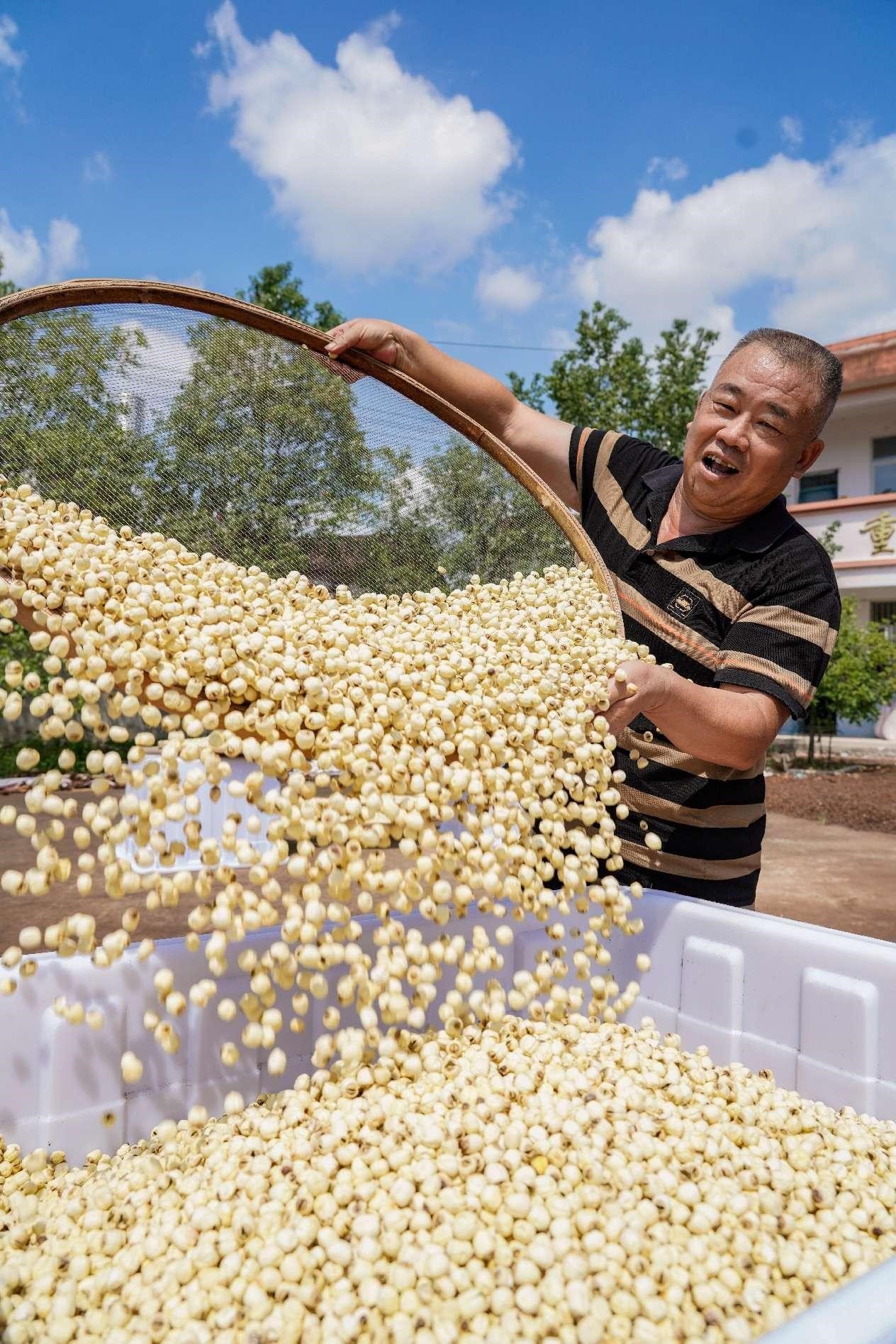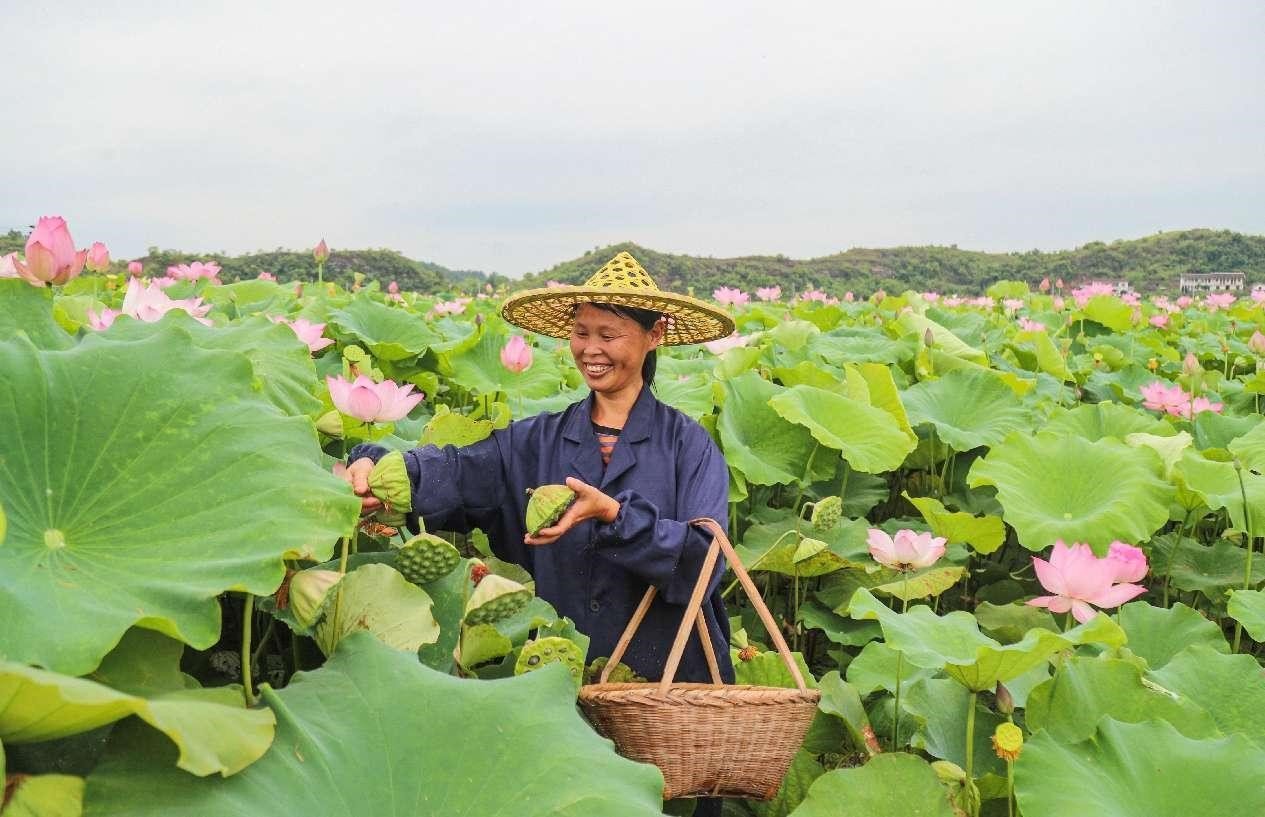Zhu Lei
In the early spring dawn, the white lotus distribution center in Guangchang County, east China’s Jiangxi province, is already bustling with activity, with buyers and sellers bargaining among mounds of white lotus seeds.
Guangchang has been cultivating lotus since the Tang Dynasty (618-907) and planting the aquatic plant on a large scale since the Qing Dynasty (1644-1911).
Today, a specialized white lotus market has taken shape here, with thousands of agricultural brokers engaging in the trade and transportation of white lotus seeds and the average daily trading volume of white lotus seeds reaching about 50,000 kilograms. The county has become a distribution and pricing center for white lotus seeds in China.

So far, Guangchang’s white lotus has been promoted nationwide with a growing area of 20 million mu (1.33 million hectares). In addition, the county has established a white lotus industrial chain with an annual comprehensive output value of more than three billion yuan ($416.8 million). Behind the thriving white lotus industry are magic space-bred seeds.
Established in 1984, the Guangchang White Lotus Research Institute strived to cultivate new varieties of lotus seeds. However, no matter how hard researchers tried, the yield per mu of lotus seeds remained at around 50 kilograms.
To break through the bottleneck problem, the institute had to take a different approach. In 1994, Liu Guangliang, the then head of the institute, attended a meeting in Beijing and learned that China was conducting space breeding to mutate genes of seeds in the special mutagenesis environment in space, to create new varieties.
That year, researchers sent 442 lotus seeds selected from over 10 lotus varieties into space by a retrievable satellite. The lotus seeds were subjected to space mutation for 14 days and were then mailed back to the institute. After categorizing and numbering the seeds by variety, staff members sowed each seed in a separate breeding container.
Unexpectedly, over 180 lotus seeds failed to germinate initially. After extensive consultations and research, researchers realized that cosmic rays in space were strong enough to fail germination of some weak seeds.
To ensure that the remaining lotus seeds would sprout, Liu and team members got to the institute early and stayed late. Lacking temperature-controlled incubators, researchers got up at 5 a.m. to put seed trays in the sun. Several months later, they achieved encouraging results: some varieties showed early ripening, with flowers being more than that of ordinary varieties, which indicated a very high yield potential.
These unique varieties were then propagated several times. After four years of careful breeding, a new variety named “No. 36 space lotus” was created, with longer growth duration, more flowers, larger lotus seedpods, higher ripening rate, and better quality. The per-mu yield of seeds of the new variety exceeded 120 kilograms.
In 1999, Guangchang started the experimental planting of the No. 36 space lotus in over 20 planting bases. At first, farmers who used to grow traditional lotus varieties were not interested in the new variety. Encouraged by technicians from the institute, Xie Changjun, the then head of Xialan village in Xujiang town, Guangchang, took the lead to plant the space lotus on four mu of land.
When summer arrived, the space lotus grew beyond Xie’s expectations, with the average yield of lotus seeds per mu of farmland reaching 130 kilograms that year. This made a splash in the whole town as crowds of people lined up in the fields to purchase Xie’s lotus seedlings.
In just a few years, the planting area of the space lotus in Guangchang exceeded 100,000 mu. Since then, the No. 36 space lotus has made its name and has been promoted to production areas of lotus seeds across China.
“A number of lotus varieties bred using the space lotus as the main breeding material have become the top choices for aquatic landscaping in China, driving the development of the country’s lotus tourism,” said Jie Zhihui, director of the white lotus industry development center in Guangchang.
Jie added that the No. 36 space lotus has been promoted across the country with a growing area of more than 20 million mu, accounting for over 80 percent of the total cultivation area of lotus seeds nationwide.

In Guangchang alone, the annual output of dried white lotus seeds reaches 9000 tons, generating an output value of 800 million yuan. In addition, the county receives 2.7 million tourist visits annually, with its tourism revenue surpassing 700 million yuan.
Guangchang is now home to several manufacturers of automatic lotus seed processing machinery, over 20 white lotus product processing enterprises, and more than 130 white lotus cooperatives, with the annual comprehensive output value of the white lotus industry exceeding three billion yuan.
To continue expanding production and strengthening brand building, Guangchang has placed importance on attracting talents and promoting innovation.
Zheng Xingwen, a genetics PhD student at Wuhan University’s College of Life Sciences in central China, is one of the outstanding talents introduced to Guangchang.
“The space lotus means utilizing the special mutagenesis environment in space to mutate genes of lotus seeds and create new varieties after space-bred seeds are brought back to earth. Today, we use gene technology to combine favorable lotus genes, so as to create new varieties,” Zheng said.
At the repository for the preservation of lotus species of a park exhibiting lotus in Guangchang, lotus varieties collected from across China are planted in thousands of large containers.
“We collect germplasm resources nationwide for purification. We have so far collected over 1,000 pieces of germplasm resources to enable genomic selection in molecular breeding. In the future, even better new space lotus varieties may emerge here,” Zheng said hopefully.
*The author is affiliated with People’s Daily, China.
Established in December 2008, The Diplomatic Insight is Pakistan’s premier diplomacy and foreign affairs magazine, available in both digital and print formats.



